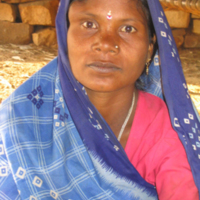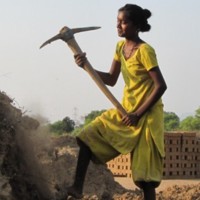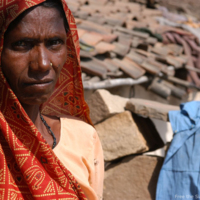
Shyamkali
In 2000, some of the 220 residents of Sonebarsa, a quarrying village in Uttar Pradesh, India, revolted against their slaveholders. About 40 families lived in Sonebarsa, all of them Kols, an ethnic group near the bottom of India’s steep ladder of caste and discrimination, and all locked into hereditary debt bondage. Children worked from the age of three or four, and infant mortality was high. Shyamkali was one of the slaves who rebelled. The villagers had begun meeting with organizers from Sankalp, a grassroots NGO that has helped thousands of slaves to free themselves from slavery in the stone quarries of Uttar Pradesh. The narrative focuses on the role of women in the process of self-liberation. Shyamkali explains that “because we are also bread earners…we also have equal role to play in fighting for our freedom. The slaves called a mass meeting, and were joined by 3,500 people from 60 villages. Slaveholders interrupted the meeting, attacked the villagers, and shot guns into the air. The villagers retaliated by throwing stones and one of the contractors was killed. His friends set fire to Sonebarsa. After the burning of Sonebarsa, Sankalp assisted the 40 refugee families and helped them form micro-credit unions. The villagers pooled their money, and petitioned for a mining lease. But the Allahabad Mining Corporation wouldn’t allow leases and so the villagers moved onto unoccupied land in Uttar Pradesh and began mining it. Authorities protested this in court, but a judge ruled that no unauthorized workwas being done and signed leases. Today the villagers continue to build their community, which they have named Azad Nagar, “the land which is free.”

Shanti
Shanti narrated her story while enslaved as a bonded laborer in the rock quarries of Uttar Pradesh, India. Debt bondage is the most common form of modern slavery. Found predominantly in South Asia and South America, it occurs when a person pledges their labor or that of a child for an indefinite period of time in return for financial credit. Debts arise in India from two main sources: an urgent crisis such as illness, injury, or famine, and the need to pay for death rites or marriage celebrations. Technically, bonded laborers can end their servitude once the debt is repaid, but this rarely occurs. A combination of low wages and high interest rates makes it impossible to repay the initial debt, and the debt usually increases because the employer deducts payment for equipment and living expenses, or charges fines for faulty work. According to India’s laws, families can simply walk away from debt and bondage, but this is usually impossible: if families try to leave, the slaveholder’s thugs retaliate with beatings, rape and forced eviction. If a family survives the beatings, they are free to starve. Without access to jobs, health care, community support or credit, independence is impossible to sustain, and they re-enter debt bondage.Though the Bonded Labor Abolition Act of 1976 criminalizes the use of the system, which is 1500 years old in India, those in debt bondage face involuntary servitude in brick kilns, rice mills, carpet looms and embroidery factories. Bonded labor is also widespread in the quarrying of granite and other stones. Workers are required to purchase their own materials, and are forced to borrow money from the contractors or quarry owners. Children aged four to 14 are required to work along with their parents for up to 14 hours a day, carrying loads of rocks in order to maximize production. Bonded children are sometimes sold to other contractors, and female workers are frequently raped. Accidents caused by explosions or drilling are common, and workers suffer from respiratory illnesses due to inhaling stone dust.

Ramphal
In 2000, some of the 220 residents of Sonebarsa, a quarrying village in Uttar Pradesh, India, revolted against their slaveholders. About 40 families lived in Sonebarsa, all of them Kols, an ethnic group near the bottom of India’s steep ladder of caste and discrimination, and all locked into hereditary debt bondage. Children worked from the age of three or four, and infant mortality was high. Ramphal was one of the slaves who rebelled. The villagers had begun meeting with organizers from Sankalp, a grassroots NGO that has so far helped 4000 slaves to free themselves from slavery in the stone quarries of Uttar Pradesh. Seeyawati, who works for Sankalp, recently explained that organizers offered the villagers two things initially: “an example of another village where we’d been able to get some progress done,” and the question: “how long could they live this life as a slave?” Bala, who also works for Sankalp, added: “Earlier on there was no hope at all amongst the people. They didn’t believe they could be free. We gave them a new hope, and said to them: ‘What has happened has happened. The past is past. But it’s up to you to make a change, because it’s your life and the lives of your children.’” The slaves called a mass meeting, and were joined by 3,500 people from 60 villages. Slaveholders interrupted the meeting, attacked the villagers, and shot guns into the air. The villagers retaliated by throwing stones and one of the contractors was killed. His friends set fire to Sonebarsa. Eight men from the village were scapegoated and jailed. Ramphal was one of these eight. After the burning of Sonebarsa, Sankalp assisted the 40 refugee families and helped them form micro-credit unions. The villagers pooled their money, and petitioned for a mining lease. But the Allahabad Mining Corporation wouldn’t allow leases and so the villagers moved onto unoccupied land in Uttar Pradesh and began mining it. Authorities protested this in court, but a judge ruled that no unauthorized workwas being done and signed leases. Today the villagers continue to build their community, which they have named Azad Nagar, “the land which is free.”

Munni
Debt bondage is the most common form of modern slavery. Found predominantly in South Asia and South America, it occurs when a person pledges their labor or that of a child for an indefinite period of time in return for financial credit. There are millions of bonded laborers in India. Debts arise from two main sources: an urgent crisis such as illness, injury, or famine, and the need to pay for death rites or marriage celebrations. Technically, bonded laborers can end their servitude once the debt is repaid, but this rarely occurs. A combination of low wages and high interest rates makes it impossible to repay the initial debt, and the debt usually increases because the employer deducts payment for equipment and living expenses, or charges fines for faulty work. According to India’s laws, families can simply walk away from debt and bondage, but this is usually impossible: if families try to leave, the slaveholder’s thugs retaliate with beatings, rape and forced eviction. If a family survives the beatings, they are free to starve. Without access to jobs, health care, community support or credit, independence is impossible to sustain, and they re-enter debt bondage. Munni Devi narrated her story while enslaved as a bonded laborer in the rock quarries of Uttar Pradesh, India. She finds the idea of escape impossible. But the day before Munni told her story in November 2004, Ramphal (an abolitionist and former quarry slave in Uttar Pradesh) explained of slaves like Munnii: “We keep…showing them…the life we lead now, and they’re keen to get out of bondage, so it’ll happen. It’s just a question of time.”